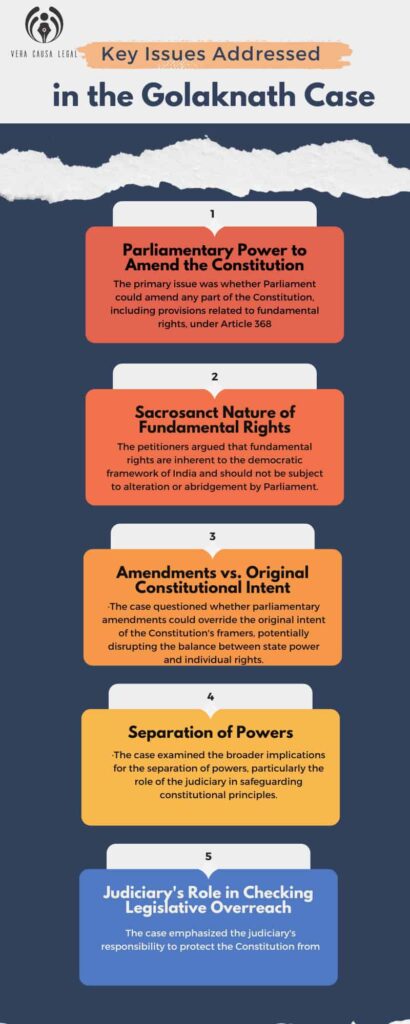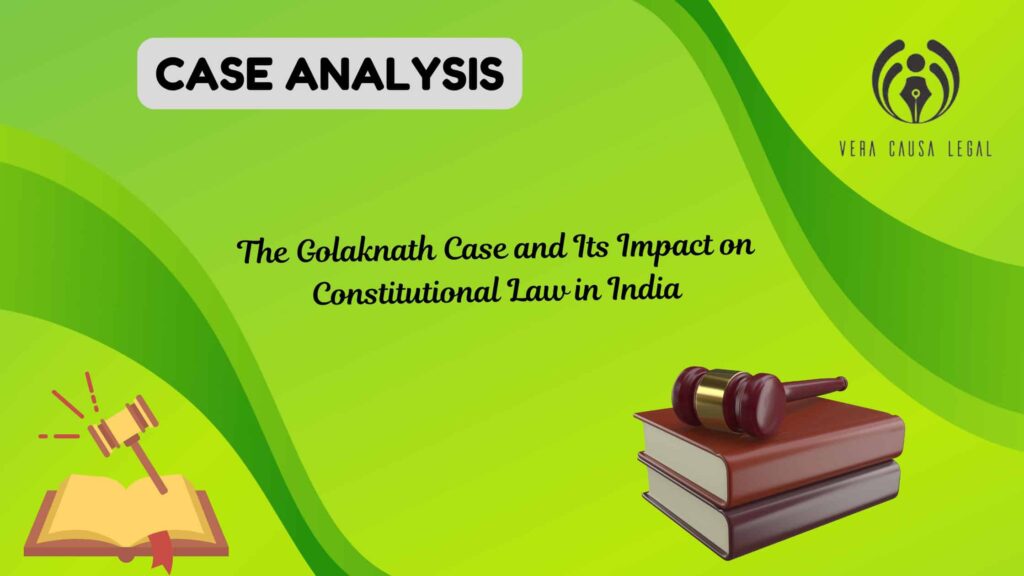The Golaknath case, formally known as I.C. Golaknath & Ors vs State Of Punjab & Anrs 1967 AIR 1643, stands as a landmark judgment in the history of Indian constitutional law. It is one of the most significant cases where the Supreme Court of India confronted the delicate balance between the Parliament’s power to amend the Constitution and the protection of fundamental rights. The judgment delivered in this case laid the groundwork for the doctrine of the “Basic Structure,” which would later become a cornerstone of Indian constitutional jurisprudence. This case study delves into the facts, arguments, and far-reaching implications of the Golaknath case, highlighting its enduring influence on India’s legal landscape.
Background and Context of the Golaknath Case
The Golaknath case emerged at a time when India was navigating the complexities of a young democracy, grappling with the tension between social justice and individual rights. In the years following independence, the Indian Parliament sought to implement various land reform laws and amend the Constitution to redistribute resources and address socio-economic inequalities. However, these amendments often encroached upon fundamental rights, particularly the right to property, enshrined in Part III of the Constitution. The petitioners in the Golaknath case, a family of landowners, challenged the constitutional validity of the Punjab Security of Land Tenures Act, 1953, and subsequent amendments made under the 17th Amendment, which they argued violated their fundamental rights. This case set the stage for a significant judicial examination of the extent of Parliament’s amending power under Article 368 of the Constitution, questioning whether it could abridge or take away fundamental rights.
Key Issues Addressed in the Golaknath Case

- Parliamentary Power to Amend the Constitution: The primary issue was whether Parliament could amend any part of the Constitution, including provisions related to fundamental rights, under Article 368.
- Sacrosanct Nature of Fundamental Rights: The petitioners argued that fundamental rights are inherent to the democratic framework of India and should not be subject to alteration or abridgement by Parliament.
- Amendments vs. Original Constitutional Intent: The case questioned whether parliamentary amendments could override the original intent of the Constitution’s framers, potentially disrupting the balance between state power and individual rights.
- Separation of Powers: The case examined the broader implications for the separation of powers, particularly the role of the judiciary in safeguarding constitutional principles.
- Judiciary’s Role in Checking Legislative Overreach: The case emphasized the judiciary’s responsibility to protect the Constitution from
Arguments Presented by the Petitioners
The petitioners, led by I.C. Golaknath, presented a robust argument emphasizing the inviolability of fundamental rights as enshrined in the Constitution of India. They contended that these rights are the cornerstone of Indian democracy, representing the essential freedoms that every citizen is entitled to. The petitioners argued that the power of Parliament under Article 368 did not extend to altering or abridging the fundamental rights listed in Part III of the Constitution. They highlighted that the Constitution was a social contract between the state and its citizens, designed to protect individual liberties against the possible tyranny of the majority. The petitioners also drew attention to the doctrine of implied limitations, asserting that certain constitutional amendments were implicitly prohibited if they undermined the very essence of the Constitution. This line of argumentation sought to establish that any amendment infringing upon fundamental rights was beyond the scope of Parliament’s powers, thus requiring judicial intervention to uphold constitutional integrity.
Arguments Presented by the Respondents
The respondents, representing the State of Punjab and the Union of India, countered the petitioners’ arguments by asserting that the Parliament possessed broad and sovereign powers to amend the Constitution under Article 368. They argued that this amending power was an essential tool for the Parliament to adapt the Constitution to the changing needs of society, especially in addressing socio-economic inequalities. The respondents contended that the term “amendment” in Article 368 included the authority to make any changes to the Constitution, including those affecting fundamental rights. They emphasized that the Parliament, as the elected representative body of the people, should have the ultimate authority to decide on matters of public interest, including the reformation of property rights and other socio-economic policies. Furthermore, the respondents argued that restricting Parliament’s amending power would undermine the flexibility of the Constitution and hinder the country’s progress towards a more equitable society. They maintained that the judiciary should respect the will of the Parliament and the democratic process, thereby allowing necessary constitutional changes to take place.
Judgment of the Supreme Court in the Golaknath Case
The Supreme Court’s judgment in the Golaknath case was a watershed moment in Indian constitutional law. In a narrow 6-5 majority decision, the Court ruled that Parliament did not have the power to amend fundamental rights under Article 368 of the Constitution. The majority opinion, led by Chief Justice Subba Rao, held that fundamental rights occupy a “transcendental position” in the constitutional framework and are beyond the reach of Parliament’s amending power. The Court emphasized that the Constitution is a living document, and the fundamental rights enshrined in it form the foundation of the democratic system, protecting citizens from the excesses of legislative power. The judgment introduced the “prospective overruling” doctrine, meaning that the ruling would not apply retroactively but only to future amendments. This landmark decision effectively curtailed Parliament’s authority to amend the Constitution in a way that could infringe upon fundamental rights, thereby reinforcing the judiciary’s role as the guardian of the Constitution.
Impact of the Golaknath Case on Indian Constitutional Law
The Golaknath case had a profound impact on the development of Indian constitutional law, particularly through its influence on the eventual establishment of the ‘Basic Structure’ doctrine. Although the Supreme Court in the Golaknath case did not explicitly articulate the Basic Structure doctrine, it laid the groundwork for this critical legal concept. The ruling underscored the idea that certain fundamental principles, such as the protection of fundamental rights, are integral to the Constitution and cannot be altered by Parliament through its amending power under Article 368.
Significance of the ‘Basic Structure’ Doctrine
The ‘Basic Structure’ doctrine was formally introduced in the landmark Kesavananda Bharati case in 1973, where the Supreme Court of India held that while Parliament has wide powers to amend the Constitution, it cannot alter or destroy its basic structure. The doctrine asserts that certain fundamental features of the Constitution—such as the rule of law, the separation of powers, judicial independence, and the protection of fundamental rights—constitute its core and are beyond the reach of parliamentary amendments.
This doctrine is significant for several reasons:
- Protection of Fundamental Rights: By ensuring that Parliament cannot amend fundamental rights in a way that violates the basic structure of the Constitution, the doctrine safeguards the individual liberties and democratic principles upon which India was founded.
- Judicial Oversight: The Basic Structure doctrine empowers the judiciary to review and strike down any constitutional amendments that threaten the core principles of the Constitution, reinforcing the judiciary’s role as the protector of constitutional integrity.
- Balance of Power: It maintains a balance of power between the different branches of government, preventing any single branch—particularly the legislature—from becoming too powerful and overriding essential constitutional principles.
- Flexibility with Limits: While the doctrine allows for constitutional amendments to address changing societal needs, it ensures that such amendments do not undermine the foundational ethos of the Constitution.
- Long-term Stability: The doctrine contributes to the long-term stability of the constitutional framework by preventing fundamental changes that could disrupt the democratic order or lead to authoritarianism.
The significance of the Basic Structure doctrine cannot be overstated, as it has become a cornerstone of Indian constitutional law. It reflects the belief that the Constitution is more than just a legal document—it embodies the fundamental values and principles that define the Indian republic. The doctrine continues to be a critical tool in ensuring that these values are preserved for future generations.
Subsequent Developments and Relevance Today
| Aspect | Details |
| Evolution of Constitutional Landscape | The Golaknath case set the stage for the emergence of the Basic Structure doctrine in the Kesavananda Bharati case (1973), which limited Parliament’s power to amend the Constitution, especially in matters related to fundamental rights. |
| Judicial Assertiveness | The Golaknath ruling marked a more assertive judiciary, willing to restrict Parliament’s ability to amend the Constitution. This was solidified in the Kesavananda Bharati case, where the Supreme Court held that Parliament cannot alter the Constitution’s basic structure. |
| Basic Structure Doctrine | The Basic Structure doctrine, established in the Kesavananda Bharati case, has been invoked in several landmark cases to strike down amendments that infringe upon the Constitution’s core principles. Examples include the Minerva Mills case (1980) and the Indira Gandhi Election case (1975). |
| Relevance of Golaknath Case | The Golaknath case remains a critical moment in India’s constitutional history, representing the judiciary’s stand to protect fundamental rights from potential legislative overreach. It is frequently cited in legal debates and judgments concerning the limits of Parliament’s power to amend the Constitution. |
| Contemporary Significance | The principles established in the Golaknath case are a reminder of the importance of safeguarding fundamental rights and maintaining the balance of power between the judiciary and the legislature, particularly in the context of ongoing constitutional amendments in contemporary India. |
| Role of Judiciary | The case underscores the judiciary’s role in ensuring that the Constitution remains a living document that evolves with society while staying true to its foundational principles. |
Conclusion
The Golaknath case is more than a landmark judgment; it is a testament to the judiciary’s enduring power in safeguarding the Constitution’s core values. By challenging Parliament’s authority to amend fundamental rights, this case paved the way for a balanced understanding of constitutional amendments. The ruling emphasized that fundamental rights are so integral to India’s democratic fabric that they must be preserved against any encroachment.
The legacy of Golaknath is best reflected in the Basic Structure doctrine, a cornerstone of Indian constitutional jurisprudence. This doctrine ensures that while the Constitution can evolve, its fundamental principles—such as individual rights, the rule of law, and the separation of powers—remain inviolable.
Today, the principles established in Golaknath continue to influence judicial decisions and constitutional interpretations. The case serves as a powerful reminder that the Constitution is not just a legal document but a living embodiment of the nation’s core values. At Vera Causa Legal, the biggest law firm in India, we are committed to upholding these constitutional values. Our firm strives to protect and advocate for the fundamental rights of our clients, ensuring that the principles from landmark cases like Golaknath continue to guide our practice.
